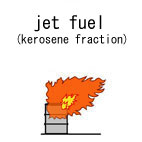| Case Name |
Fire of a soil-covered underground oil tank of U.S. Army caused due to hot work at an adjacent tank |
| Pictograph |

|
| Date |
October 13, 1981 |
| Place |
Yokohama, Kanagawa, Japan |
| Location |
US Navy's establishment |
| Overview |
Near the discharge nozzle of a soil-covered tank vent pipe, hot work at an adjacent tank was carried out. Vapor from jet fuel in a vent pipe was ignited by a spark, caught fire and it became full-surface tank fire of 32500 kL. The fire was extinguished within about four hours. There is a big possibility that safety management was imperfect at U.S. Army facilities. (At U.S. Army facilities, the user of the facilities is the U.S. Army, construction management is provided by the Defense Facilities Administration Agency, and the work is done by a private enterprise.) Generally, only safety management regulations of the U.S. Army are applied to a tank, as municipal law are not applied. |
| Incident |
The 32500 kL soil-covered tank for jet fuel of the U.S. Army caught fire due to hot work nearby, and it became a full-surface tank fire. |
| Processing |
Storage |
| Substance |
Jet fuel |
| Type of Accident |
Fire |
| Sequence |
As the fire occurred in the U.S. military base, the details have not been clarified. The tank was an old fuel tank that had been used by the Japanese army, and was used by the US army after being requisitioned. On the day of the accident, an inspection of the decrepit place was carried out inside an adjoining tank using an electric device. The accident suddenly occurred. |
| Cause |
Vapor from the vent pipe of the accident tank was ignited by a spark from a welding machine, etc. used in hot work at an adjacent tank, and it might have entered the tank via a vent pipe. |
| Response |
Fire-extinguishing activities were conducted by public fire-fighters and U.S. Army. |
| Countermeasures |
1. Countermeasures against US army facilities (User; US army. Orderer; Defense Facilities Administration Agency, Subcontractor; A private company)
2. Thorough fire management during repairs. |
| Knowledge Comment |
There are many fires caused by hot work. Although a soil-covered tank is safe, there is some danger because the vent pipe is near the ground. |
| Background |
The basic factor is considered to be insufficient fire control during repairs. It is not assumed that U.S. Army and the Defense Facilities Administration Agency required manuals to be prepared. |
| Sequel |
Radiant heat measurement and estimation from the fire were made by the public fire brigade. |
| Incidental Discussion |
Dealing with a fire in U.S. Army facilities is very difficult because administrative rights of the Japanese government do not cover them. In spite of this, the fire was extinguished in a short time. It was confirmed that the soil-covered tank was safe and allowed easy fire extinguishing activities. Fire management is only necessary so that combustible vapor does not catch fire because discharge of a vent pipe of a soil-covered tank is near the ground. |
| Reason for Adding to DB |
Example of fire at vent piping of a soil-covered tank, which was thought to be safer than a normal tank |
| Scenario |
| Primary Scenario
|
Poor Value Perception, Poor Safety Awareness, Insufficient Safety Measure, Organizational Problems, Inflexible Management Structure, Insufficient Information and Communication, Carelessness, Insufficient Precaution, Supervisor Carelessness, Planning and Design, Poor Planning, Poor Planning of Repair, Non-Regular Action, Inaction, No Safety Reconfirmation, Bad Event, Chemical Phenomenon, Burning, Secondary Damage, External Damage, Fire, Bodily Harm, Injury, 9 person injured, Loss to Organization, Economic Loss, Damage to Society, Social Systems Failure
|
|
| Sources |
Kiyohisa and Isa, Thermal radiation from JP-4 tank fire. Safety engineering Vol.23 No.4 pp.227-234 (1984)
Yokohama City, Fire-fighting training center. Research and Development section, danger of fire and example of accident with jet fuel JP-4. Monthly fire fighting, No.73 pp.42-53 (1985)
|
| Number of Injuries |
5 |
| Physical Damage |
A cylindrical soil-covered tank and a concrete canopy of the tank and an earthen cover were damaged. (Fire department of Yokohama City) A total of 474 nearby housing units were damaged (material of Chemical fire committee). |
| Consequences |
The Fire station in Yokohama City gave an evacuation order to about 900 inhabitants of Murasaki town and Nagahama town in Yokohama near the US base. Inhabitants temporally evacuated to public gymnasiums, and other places. |
| Field |
Chemicals and Plants
|
| Author |
KOSEKI, Hirosi (National Research Institute of Fire and Disaster)
TAMURA, Masamitsu (Center for Risk Management and Safety Sciences, Yokohama National University)
|